The Macroeconomic Environment in China: An Investment Analysis
VerifiedAdded on 2021/05/27
|35
|8957
|31
Report
AI Summary
This report provides a comprehensive analysis of the macroeconomic conditions in China, focusing on its suitability as an investment destination, particularly for the textile manufacturing industry. It examines various macroeconomic variables, including economic growth, business cycles, unemployment, wage rates, human capital, inflation, real interest rates, government expenditure, and the impact of the Global Financial Crisis. The report explores the general business environment in China, detailing the ease of setting up a business, the different business structures available to foreign investors (WFOE, PE, Representative Office, FIPE), and the processes involved in obtaining construction permits and electricity connections. It also covers the requirements for obtaining credit from Chinese financial institutions. The analysis concludes that China's robust economy, favorable business environment, and openness to international trade make it a prudent choice for the Australian-based company to establish a textile manufacturing firm. The report offers recommendations based on the macroeconomic conditions and business environment.
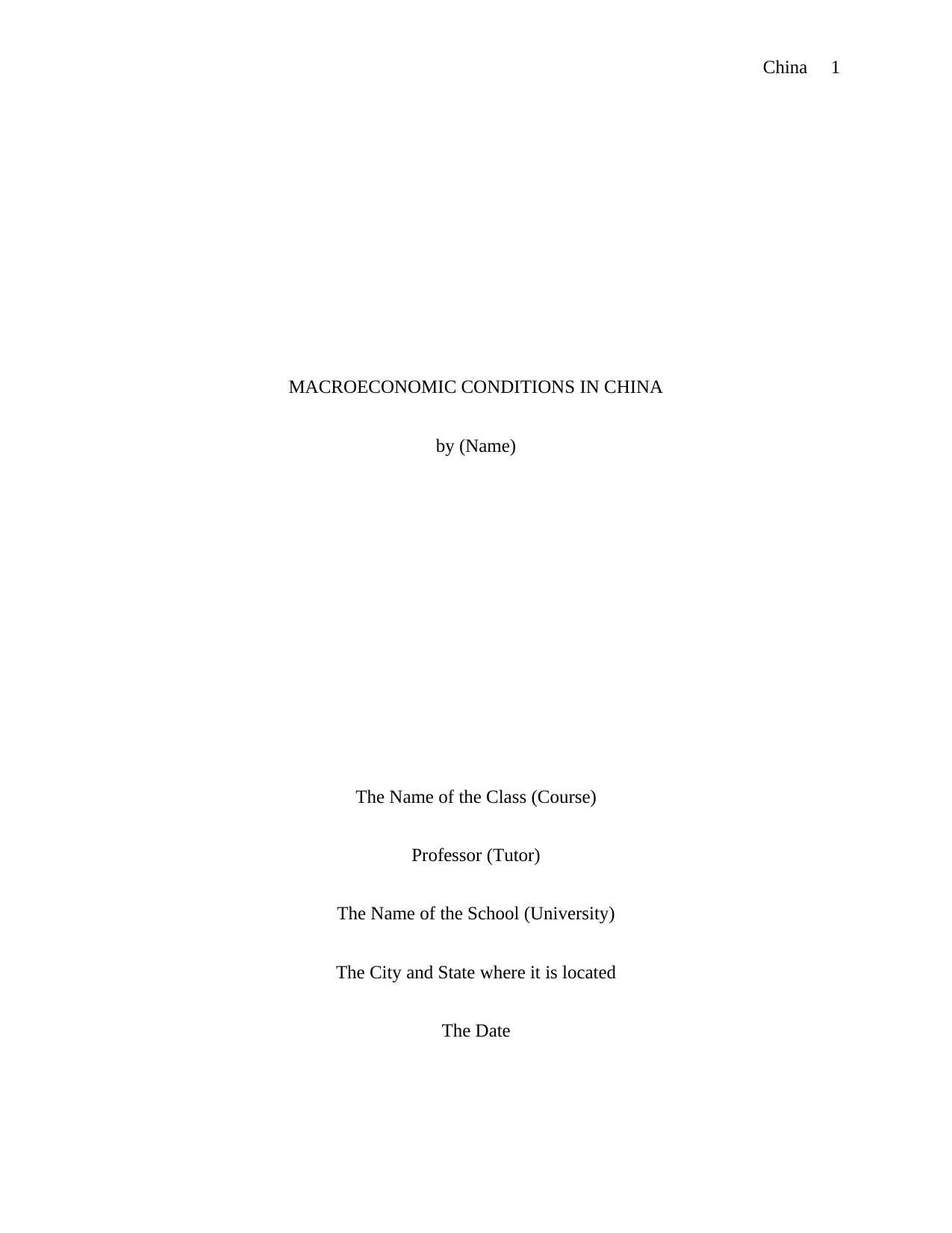
China 1
MACROECONOMIC CONDITIONS IN CHINA
by (Name)
The Name of the Class (Course)
Professor (Tutor)
The Name of the School (University)
The City and State where it is located
The Date
MACROECONOMIC CONDITIONS IN CHINA
by (Name)
The Name of the Class (Course)
Professor (Tutor)
The Name of the School (University)
The City and State where it is located
The Date
Paraphrase This Document
Need a fresh take? Get an instant paraphrase of this document with our AI Paraphraser
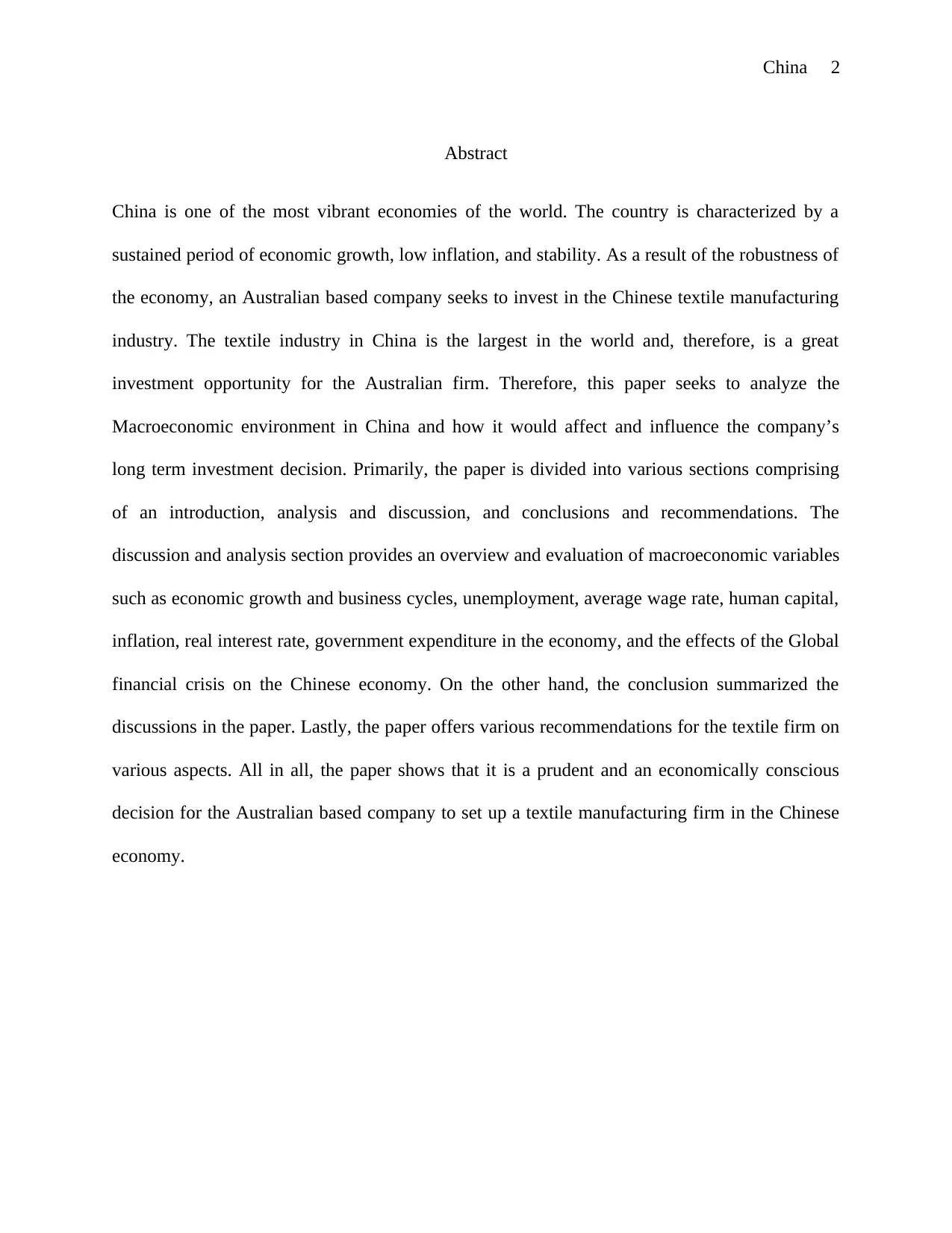
China 2
Abstract
China is one of the most vibrant economies of the world. The country is characterized by a
sustained period of economic growth, low inflation, and stability. As a result of the robustness of
the economy, an Australian based company seeks to invest in the Chinese textile manufacturing
industry. The textile industry in China is the largest in the world and, therefore, is a great
investment opportunity for the Australian firm. Therefore, this paper seeks to analyze the
Macroeconomic environment in China and how it would affect and influence the company’s
long term investment decision. Primarily, the paper is divided into various sections comprising
of an introduction, analysis and discussion, and conclusions and recommendations. The
discussion and analysis section provides an overview and evaluation of macroeconomic variables
such as economic growth and business cycles, unemployment, average wage rate, human capital,
inflation, real interest rate, government expenditure in the economy, and the effects of the Global
financial crisis on the Chinese economy. On the other hand, the conclusion summarized the
discussions in the paper. Lastly, the paper offers various recommendations for the textile firm on
various aspects. All in all, the paper shows that it is a prudent and an economically conscious
decision for the Australian based company to set up a textile manufacturing firm in the Chinese
economy.
Abstract
China is one of the most vibrant economies of the world. The country is characterized by a
sustained period of economic growth, low inflation, and stability. As a result of the robustness of
the economy, an Australian based company seeks to invest in the Chinese textile manufacturing
industry. The textile industry in China is the largest in the world and, therefore, is a great
investment opportunity for the Australian firm. Therefore, this paper seeks to analyze the
Macroeconomic environment in China and how it would affect and influence the company’s
long term investment decision. Primarily, the paper is divided into various sections comprising
of an introduction, analysis and discussion, and conclusions and recommendations. The
discussion and analysis section provides an overview and evaluation of macroeconomic variables
such as economic growth and business cycles, unemployment, average wage rate, human capital,
inflation, real interest rate, government expenditure in the economy, and the effects of the Global
financial crisis on the Chinese economy. On the other hand, the conclusion summarized the
discussions in the paper. Lastly, the paper offers various recommendations for the textile firm on
various aspects. All in all, the paper shows that it is a prudent and an economically conscious
decision for the Australian based company to set up a textile manufacturing firm in the Chinese
economy.
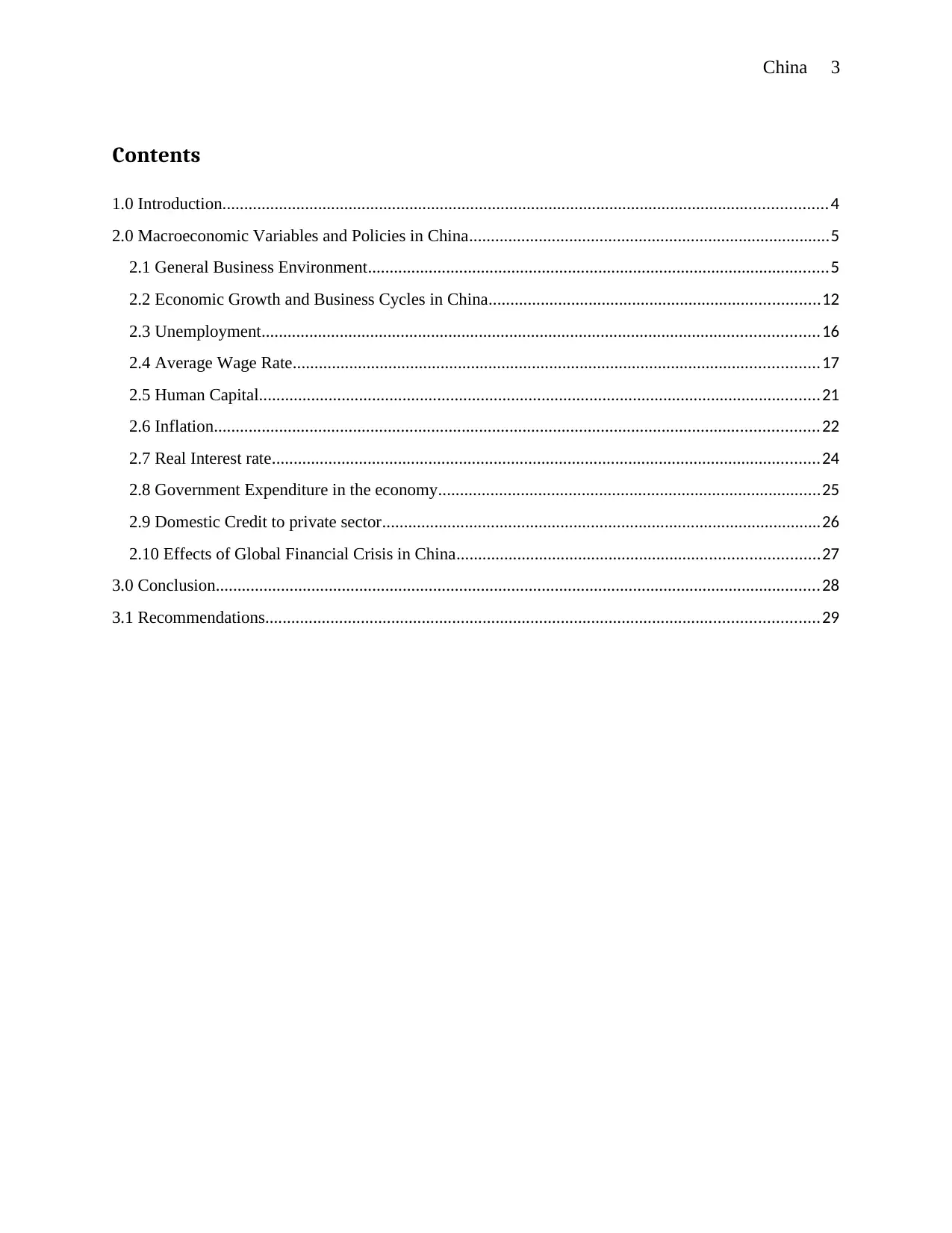
China 3
Contents
1.0 Introduction...........................................................................................................................................4
2.0 Macroeconomic Variables and Policies in China...................................................................................5
2.1 General Business Environment..........................................................................................................5
2.2 Economic Growth and Business Cycles in China............................................................................12
2.3 Unemployment................................................................................................................................16
2.4 Average Wage Rate.........................................................................................................................17
2.5 Human Capital.................................................................................................................................21
2.6 Inflation...........................................................................................................................................22
2.7 Real Interest rate..............................................................................................................................24
2.8 Government Expenditure in the economy........................................................................................25
2.9 Domestic Credit to private sector.....................................................................................................26
2.10 Effects of Global Financial Crisis in China...................................................................................27
3.0 Conclusion...........................................................................................................................................28
3.1 Recommendations...............................................................................................................................29
Contents
1.0 Introduction...........................................................................................................................................4
2.0 Macroeconomic Variables and Policies in China...................................................................................5
2.1 General Business Environment..........................................................................................................5
2.2 Economic Growth and Business Cycles in China............................................................................12
2.3 Unemployment................................................................................................................................16
2.4 Average Wage Rate.........................................................................................................................17
2.5 Human Capital.................................................................................................................................21
2.6 Inflation...........................................................................................................................................22
2.7 Real Interest rate..............................................................................................................................24
2.8 Government Expenditure in the economy........................................................................................25
2.9 Domestic Credit to private sector.....................................................................................................26
2.10 Effects of Global Financial Crisis in China...................................................................................27
3.0 Conclusion...........................................................................................................................................28
3.1 Recommendations...............................................................................................................................29
⊘ This is a preview!⊘
Do you want full access?
Subscribe today to unlock all pages.

Trusted by 1+ million students worldwide
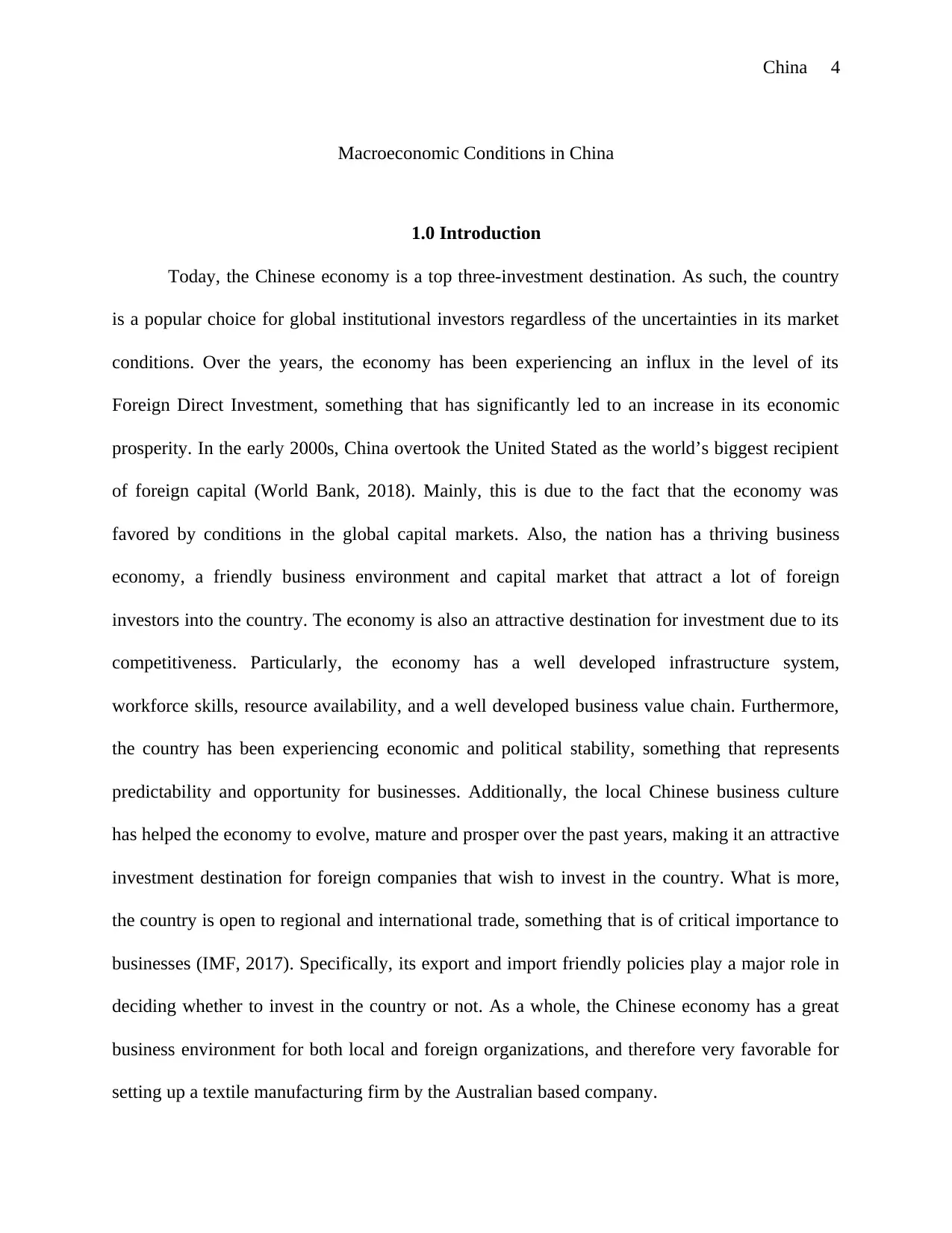
China 4
Macroeconomic Conditions in China
1.0 Introduction
Today, the Chinese economy is a top three-investment destination. As such, the country
is a popular choice for global institutional investors regardless of the uncertainties in its market
conditions. Over the years, the economy has been experiencing an influx in the level of its
Foreign Direct Investment, something that has significantly led to an increase in its economic
prosperity. In the early 2000s, China overtook the United Stated as the world’s biggest recipient
of foreign capital (World Bank, 2018). Mainly, this is due to the fact that the economy was
favored by conditions in the global capital markets. Also, the nation has a thriving business
economy, a friendly business environment and capital market that attract a lot of foreign
investors into the country. The economy is also an attractive destination for investment due to its
competitiveness. Particularly, the economy has a well developed infrastructure system,
workforce skills, resource availability, and a well developed business value chain. Furthermore,
the country has been experiencing economic and political stability, something that represents
predictability and opportunity for businesses. Additionally, the local Chinese business culture
has helped the economy to evolve, mature and prosper over the past years, making it an attractive
investment destination for foreign companies that wish to invest in the country. What is more,
the country is open to regional and international trade, something that is of critical importance to
businesses (IMF, 2017). Specifically, its export and import friendly policies play a major role in
deciding whether to invest in the country or not. As a whole, the Chinese economy has a great
business environment for both local and foreign organizations, and therefore very favorable for
setting up a textile manufacturing firm by the Australian based company.
Macroeconomic Conditions in China
1.0 Introduction
Today, the Chinese economy is a top three-investment destination. As such, the country
is a popular choice for global institutional investors regardless of the uncertainties in its market
conditions. Over the years, the economy has been experiencing an influx in the level of its
Foreign Direct Investment, something that has significantly led to an increase in its economic
prosperity. In the early 2000s, China overtook the United Stated as the world’s biggest recipient
of foreign capital (World Bank, 2018). Mainly, this is due to the fact that the economy was
favored by conditions in the global capital markets. Also, the nation has a thriving business
economy, a friendly business environment and capital market that attract a lot of foreign
investors into the country. The economy is also an attractive destination for investment due to its
competitiveness. Particularly, the economy has a well developed infrastructure system,
workforce skills, resource availability, and a well developed business value chain. Furthermore,
the country has been experiencing economic and political stability, something that represents
predictability and opportunity for businesses. Additionally, the local Chinese business culture
has helped the economy to evolve, mature and prosper over the past years, making it an attractive
investment destination for foreign companies that wish to invest in the country. What is more,
the country is open to regional and international trade, something that is of critical importance to
businesses (IMF, 2017). Specifically, its export and import friendly policies play a major role in
deciding whether to invest in the country or not. As a whole, the Chinese economy has a great
business environment for both local and foreign organizations, and therefore very favorable for
setting up a textile manufacturing firm by the Australian based company.
Paraphrase This Document
Need a fresh take? Get an instant paraphrase of this document with our AI Paraphraser
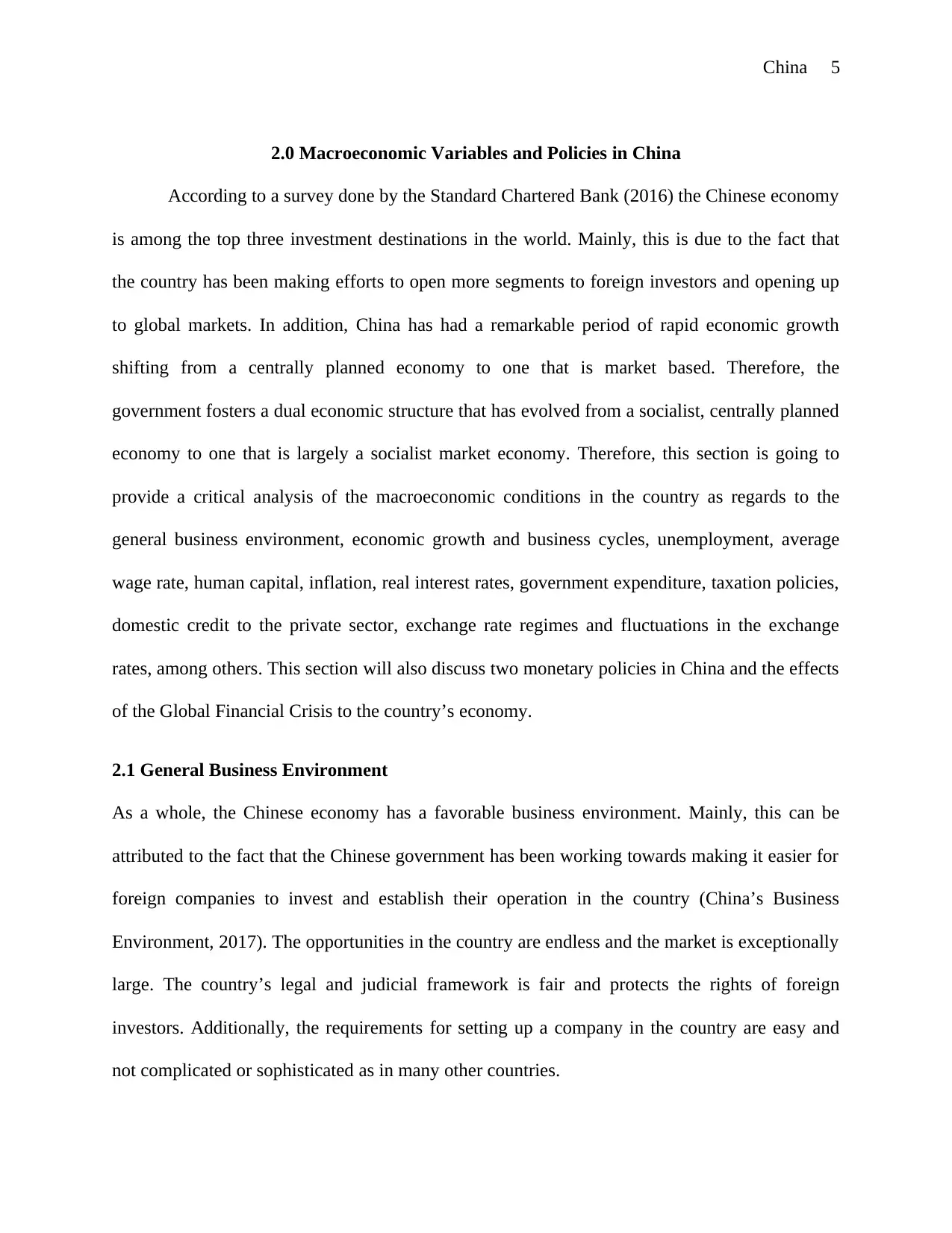
China 5
2.0 Macroeconomic Variables and Policies in China
According to a survey done by the Standard Chartered Bank (2016) the Chinese economy
is among the top three investment destinations in the world. Mainly, this is due to the fact that
the country has been making efforts to open more segments to foreign investors and opening up
to global markets. In addition, China has had a remarkable period of rapid economic growth
shifting from a centrally planned economy to one that is market based. Therefore, the
government fosters a dual economic structure that has evolved from a socialist, centrally planned
economy to one that is largely a socialist market economy. Therefore, this section is going to
provide a critical analysis of the macroeconomic conditions in the country as regards to the
general business environment, economic growth and business cycles, unemployment, average
wage rate, human capital, inflation, real interest rates, government expenditure, taxation policies,
domestic credit to the private sector, exchange rate regimes and fluctuations in the exchange
rates, among others. This section will also discuss two monetary policies in China and the effects
of the Global Financial Crisis to the country’s economy.
2.1 General Business Environment
As a whole, the Chinese economy has a favorable business environment. Mainly, this can be
attributed to the fact that the Chinese government has been working towards making it easier for
foreign companies to invest and establish their operation in the country (China’s Business
Environment, 2017). The opportunities in the country are endless and the market is exceptionally
large. The country’s legal and judicial framework is fair and protects the rights of foreign
investors. Additionally, the requirements for setting up a company in the country are easy and
not complicated or sophisticated as in many other countries.
2.0 Macroeconomic Variables and Policies in China
According to a survey done by the Standard Chartered Bank (2016) the Chinese economy
is among the top three investment destinations in the world. Mainly, this is due to the fact that
the country has been making efforts to open more segments to foreign investors and opening up
to global markets. In addition, China has had a remarkable period of rapid economic growth
shifting from a centrally planned economy to one that is market based. Therefore, the
government fosters a dual economic structure that has evolved from a socialist, centrally planned
economy to one that is largely a socialist market economy. Therefore, this section is going to
provide a critical analysis of the macroeconomic conditions in the country as regards to the
general business environment, economic growth and business cycles, unemployment, average
wage rate, human capital, inflation, real interest rates, government expenditure, taxation policies,
domestic credit to the private sector, exchange rate regimes and fluctuations in the exchange
rates, among others. This section will also discuss two monetary policies in China and the effects
of the Global Financial Crisis to the country’s economy.
2.1 General Business Environment
As a whole, the Chinese economy has a favorable business environment. Mainly, this can be
attributed to the fact that the Chinese government has been working towards making it easier for
foreign companies to invest and establish their operation in the country (China’s Business
Environment, 2017). The opportunities in the country are endless and the market is exceptionally
large. The country’s legal and judicial framework is fair and protects the rights of foreign
investors. Additionally, the requirements for setting up a company in the country are easy and
not complicated or sophisticated as in many other countries.
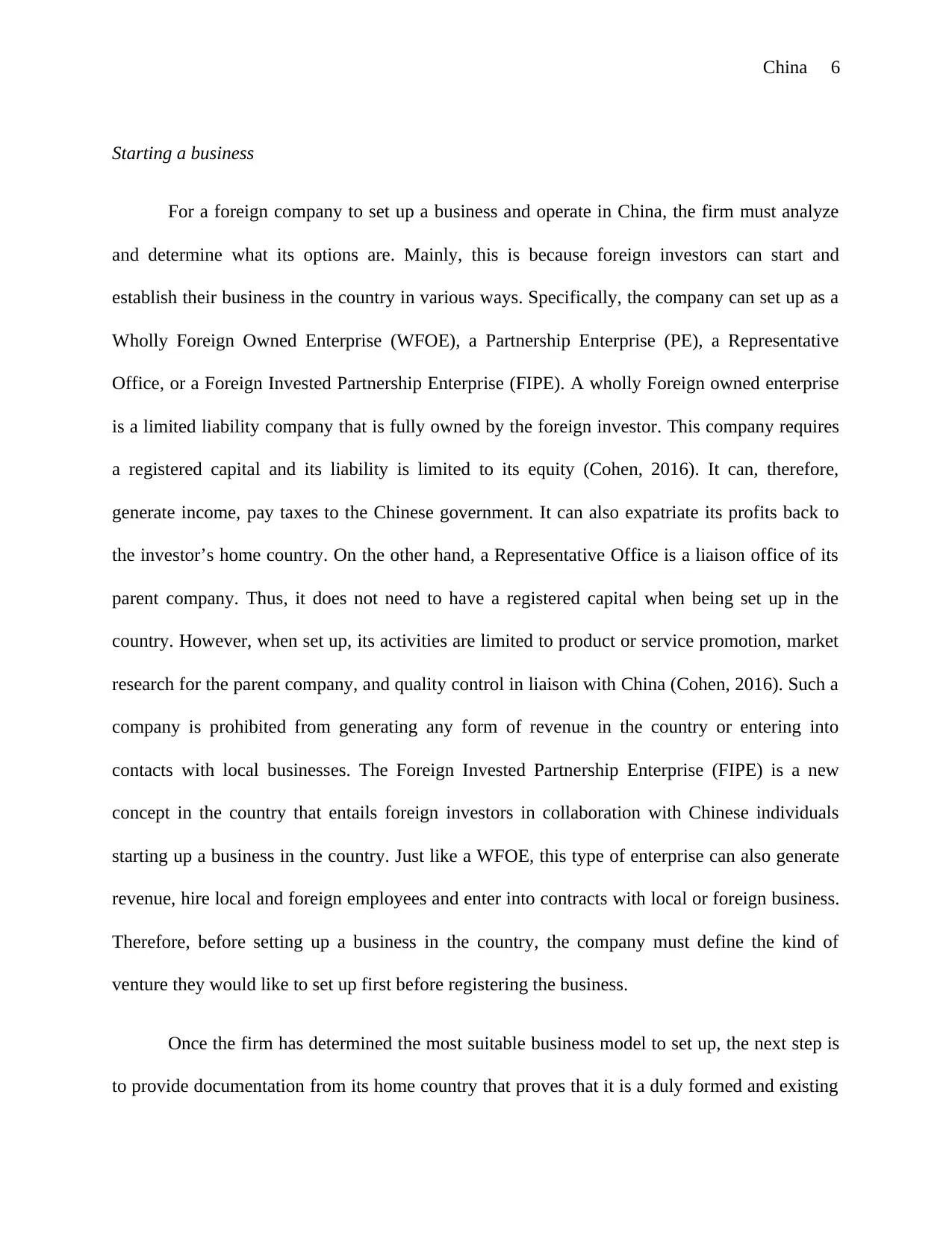
China 6
Starting a business
For a foreign company to set up a business and operate in China, the firm must analyze
and determine what its options are. Mainly, this is because foreign investors can start and
establish their business in the country in various ways. Specifically, the company can set up as a
Wholly Foreign Owned Enterprise (WFOE), a Partnership Enterprise (PE), a Representative
Office, or a Foreign Invested Partnership Enterprise (FIPE). A wholly Foreign owned enterprise
is a limited liability company that is fully owned by the foreign investor. This company requires
a registered capital and its liability is limited to its equity (Cohen, 2016). It can, therefore,
generate income, pay taxes to the Chinese government. It can also expatriate its profits back to
the investor’s home country. On the other hand, a Representative Office is a liaison office of its
parent company. Thus, it does not need to have a registered capital when being set up in the
country. However, when set up, its activities are limited to product or service promotion, market
research for the parent company, and quality control in liaison with China (Cohen, 2016). Such a
company is prohibited from generating any form of revenue in the country or entering into
contacts with local businesses. The Foreign Invested Partnership Enterprise (FIPE) is a new
concept in the country that entails foreign investors in collaboration with Chinese individuals
starting up a business in the country. Just like a WFOE, this type of enterprise can also generate
revenue, hire local and foreign employees and enter into contracts with local or foreign business.
Therefore, before setting up a business in the country, the company must define the kind of
venture they would like to set up first before registering the business.
Once the firm has determined the most suitable business model to set up, the next step is
to provide documentation from its home country that proves that it is a duly formed and existing
Starting a business
For a foreign company to set up a business and operate in China, the firm must analyze
and determine what its options are. Mainly, this is because foreign investors can start and
establish their business in the country in various ways. Specifically, the company can set up as a
Wholly Foreign Owned Enterprise (WFOE), a Partnership Enterprise (PE), a Representative
Office, or a Foreign Invested Partnership Enterprise (FIPE). A wholly Foreign owned enterprise
is a limited liability company that is fully owned by the foreign investor. This company requires
a registered capital and its liability is limited to its equity (Cohen, 2016). It can, therefore,
generate income, pay taxes to the Chinese government. It can also expatriate its profits back to
the investor’s home country. On the other hand, a Representative Office is a liaison office of its
parent company. Thus, it does not need to have a registered capital when being set up in the
country. However, when set up, its activities are limited to product or service promotion, market
research for the parent company, and quality control in liaison with China (Cohen, 2016). Such a
company is prohibited from generating any form of revenue in the country or entering into
contacts with local businesses. The Foreign Invested Partnership Enterprise (FIPE) is a new
concept in the country that entails foreign investors in collaboration with Chinese individuals
starting up a business in the country. Just like a WFOE, this type of enterprise can also generate
revenue, hire local and foreign employees and enter into contracts with local or foreign business.
Therefore, before setting up a business in the country, the company must define the kind of
venture they would like to set up first before registering the business.
Once the firm has determined the most suitable business model to set up, the next step is
to provide documentation from its home country that proves that it is a duly formed and existing
⊘ This is a preview!⊘
Do you want full access?
Subscribe today to unlock all pages.

Trusted by 1+ million students worldwide
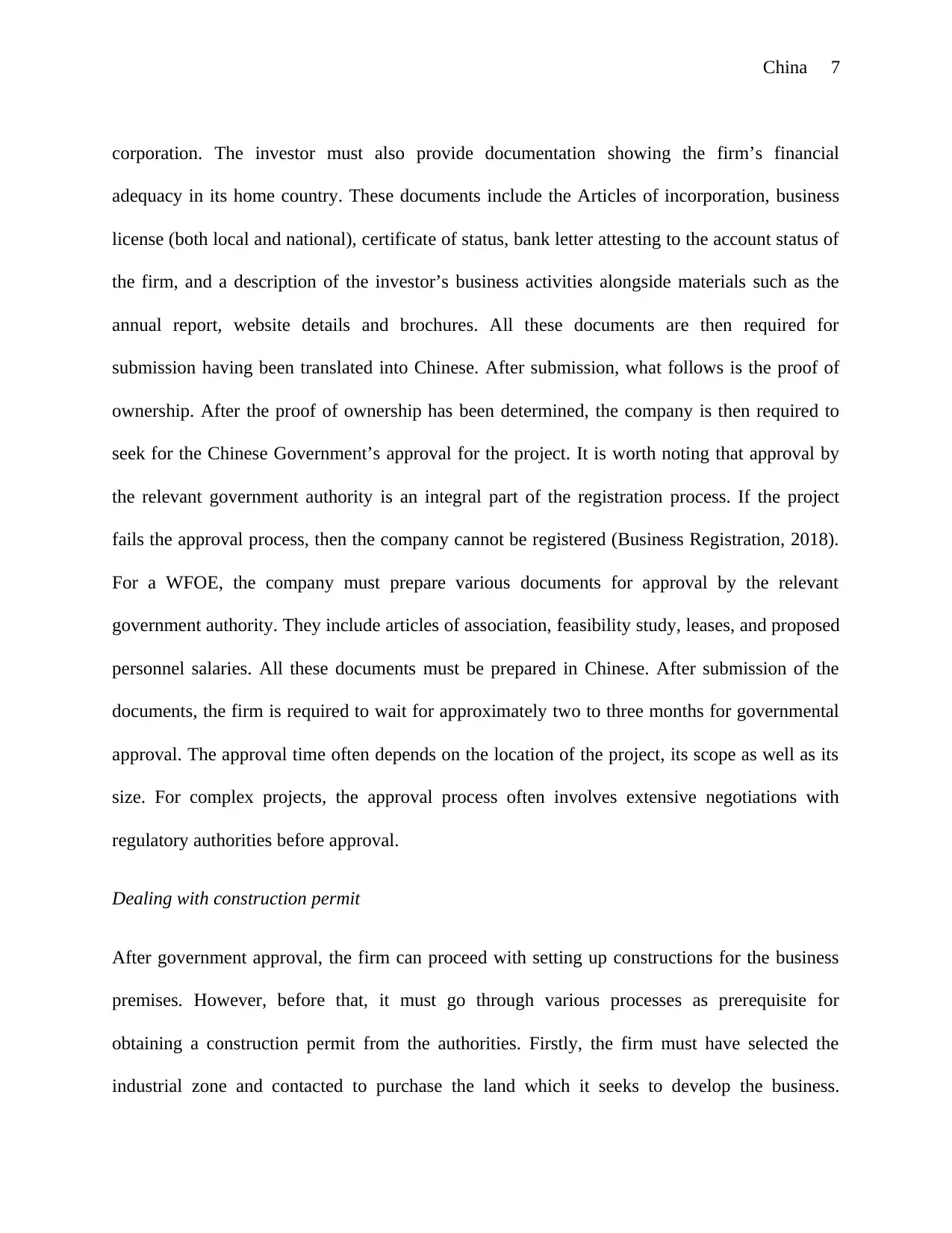
China 7
corporation. The investor must also provide documentation showing the firm’s financial
adequacy in its home country. These documents include the Articles of incorporation, business
license (both local and national), certificate of status, bank letter attesting to the account status of
the firm, and a description of the investor’s business activities alongside materials such as the
annual report, website details and brochures. All these documents are then required for
submission having been translated into Chinese. After submission, what follows is the proof of
ownership. After the proof of ownership has been determined, the company is then required to
seek for the Chinese Government’s approval for the project. It is worth noting that approval by
the relevant government authority is an integral part of the registration process. If the project
fails the approval process, then the company cannot be registered (Business Registration, 2018).
For a WFOE, the company must prepare various documents for approval by the relevant
government authority. They include articles of association, feasibility study, leases, and proposed
personnel salaries. All these documents must be prepared in Chinese. After submission of the
documents, the firm is required to wait for approximately two to three months for governmental
approval. The approval time often depends on the location of the project, its scope as well as its
size. For complex projects, the approval process often involves extensive negotiations with
regulatory authorities before approval.
Dealing with construction permit
After government approval, the firm can proceed with setting up constructions for the business
premises. However, before that, it must go through various processes as prerequisite for
obtaining a construction permit from the authorities. Firstly, the firm must have selected the
industrial zone and contacted to purchase the land which it seeks to develop the business.
corporation. The investor must also provide documentation showing the firm’s financial
adequacy in its home country. These documents include the Articles of incorporation, business
license (both local and national), certificate of status, bank letter attesting to the account status of
the firm, and a description of the investor’s business activities alongside materials such as the
annual report, website details and brochures. All these documents are then required for
submission having been translated into Chinese. After submission, what follows is the proof of
ownership. After the proof of ownership has been determined, the company is then required to
seek for the Chinese Government’s approval for the project. It is worth noting that approval by
the relevant government authority is an integral part of the registration process. If the project
fails the approval process, then the company cannot be registered (Business Registration, 2018).
For a WFOE, the company must prepare various documents for approval by the relevant
government authority. They include articles of association, feasibility study, leases, and proposed
personnel salaries. All these documents must be prepared in Chinese. After submission of the
documents, the firm is required to wait for approximately two to three months for governmental
approval. The approval time often depends on the location of the project, its scope as well as its
size. For complex projects, the approval process often involves extensive negotiations with
regulatory authorities before approval.
Dealing with construction permit
After government approval, the firm can proceed with setting up constructions for the business
premises. However, before that, it must go through various processes as prerequisite for
obtaining a construction permit from the authorities. Firstly, the firm must have selected the
industrial zone and contacted to purchase the land which it seeks to develop the business.
Paraphrase This Document
Need a fresh take? Get an instant paraphrase of this document with our AI Paraphraser
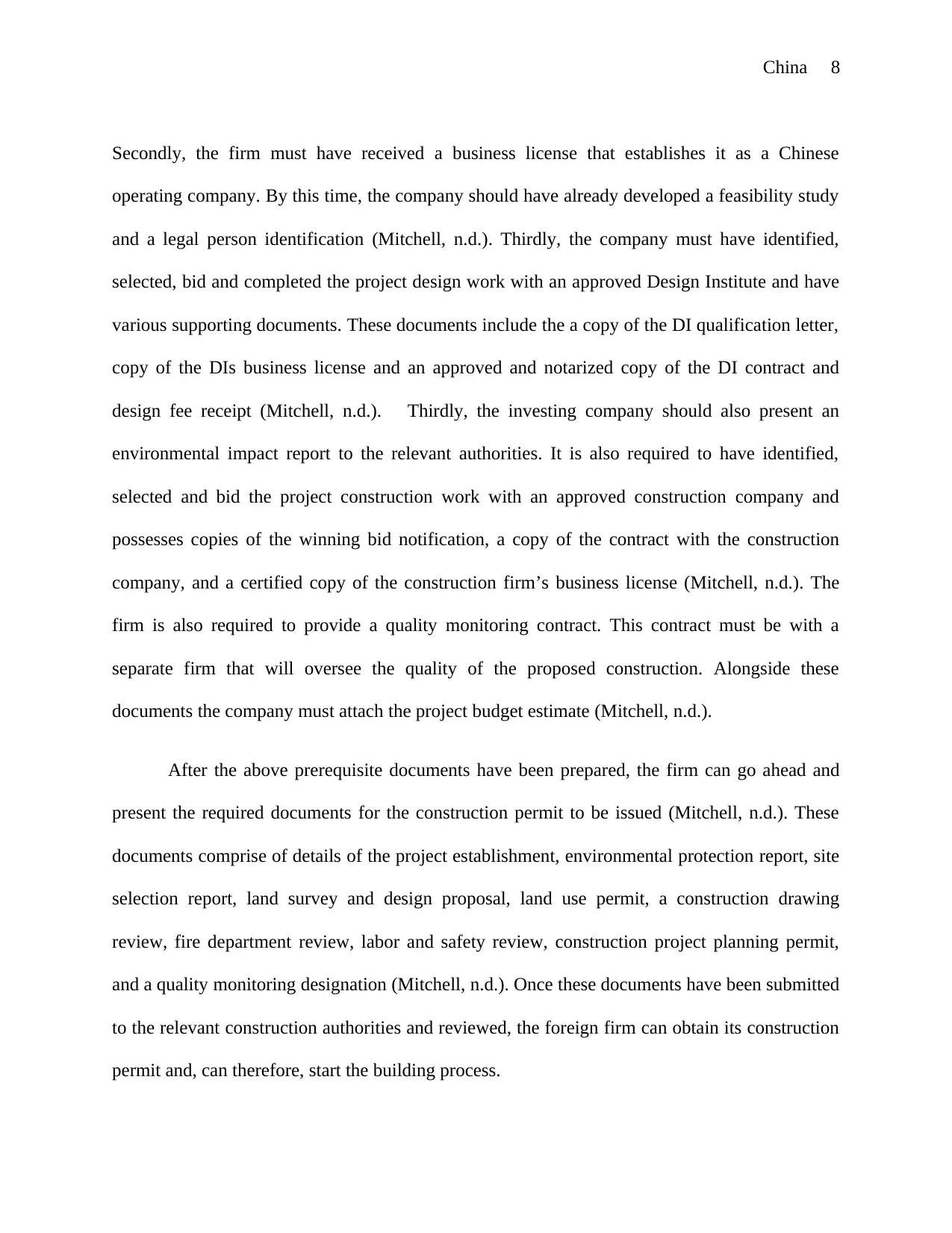
China 8
Secondly, the firm must have received a business license that establishes it as a Chinese
operating company. By this time, the company should have already developed a feasibility study
and a legal person identification (Mitchell, n.d.). Thirdly, the company must have identified,
selected, bid and completed the project design work with an approved Design Institute and have
various supporting documents. These documents include the a copy of the DI qualification letter,
copy of the DIs business license and an approved and notarized copy of the DI contract and
design fee receipt (Mitchell, n.d.). Thirdly, the investing company should also present an
environmental impact report to the relevant authorities. It is also required to have identified,
selected and bid the project construction work with an approved construction company and
possesses copies of the winning bid notification, a copy of the contract with the construction
company, and a certified copy of the construction firm’s business license (Mitchell, n.d.). The
firm is also required to provide a quality monitoring contract. This contract must be with a
separate firm that will oversee the quality of the proposed construction. Alongside these
documents the company must attach the project budget estimate (Mitchell, n.d.).
After the above prerequisite documents have been prepared, the firm can go ahead and
present the required documents for the construction permit to be issued (Mitchell, n.d.). These
documents comprise of details of the project establishment, environmental protection report, site
selection report, land survey and design proposal, land use permit, a construction drawing
review, fire department review, labor and safety review, construction project planning permit,
and a quality monitoring designation (Mitchell, n.d.). Once these documents have been submitted
to the relevant construction authorities and reviewed, the foreign firm can obtain its construction
permit and, can therefore, start the building process.
Secondly, the firm must have received a business license that establishes it as a Chinese
operating company. By this time, the company should have already developed a feasibility study
and a legal person identification (Mitchell, n.d.). Thirdly, the company must have identified,
selected, bid and completed the project design work with an approved Design Institute and have
various supporting documents. These documents include the a copy of the DI qualification letter,
copy of the DIs business license and an approved and notarized copy of the DI contract and
design fee receipt (Mitchell, n.d.). Thirdly, the investing company should also present an
environmental impact report to the relevant authorities. It is also required to have identified,
selected and bid the project construction work with an approved construction company and
possesses copies of the winning bid notification, a copy of the contract with the construction
company, and a certified copy of the construction firm’s business license (Mitchell, n.d.). The
firm is also required to provide a quality monitoring contract. This contract must be with a
separate firm that will oversee the quality of the proposed construction. Alongside these
documents the company must attach the project budget estimate (Mitchell, n.d.).
After the above prerequisite documents have been prepared, the firm can go ahead and
present the required documents for the construction permit to be issued (Mitchell, n.d.). These
documents comprise of details of the project establishment, environmental protection report, site
selection report, land survey and design proposal, land use permit, a construction drawing
review, fire department review, labor and safety review, construction project planning permit,
and a quality monitoring designation (Mitchell, n.d.). Once these documents have been submitted
to the relevant construction authorities and reviewed, the foreign firm can obtain its construction
permit and, can therefore, start the building process.
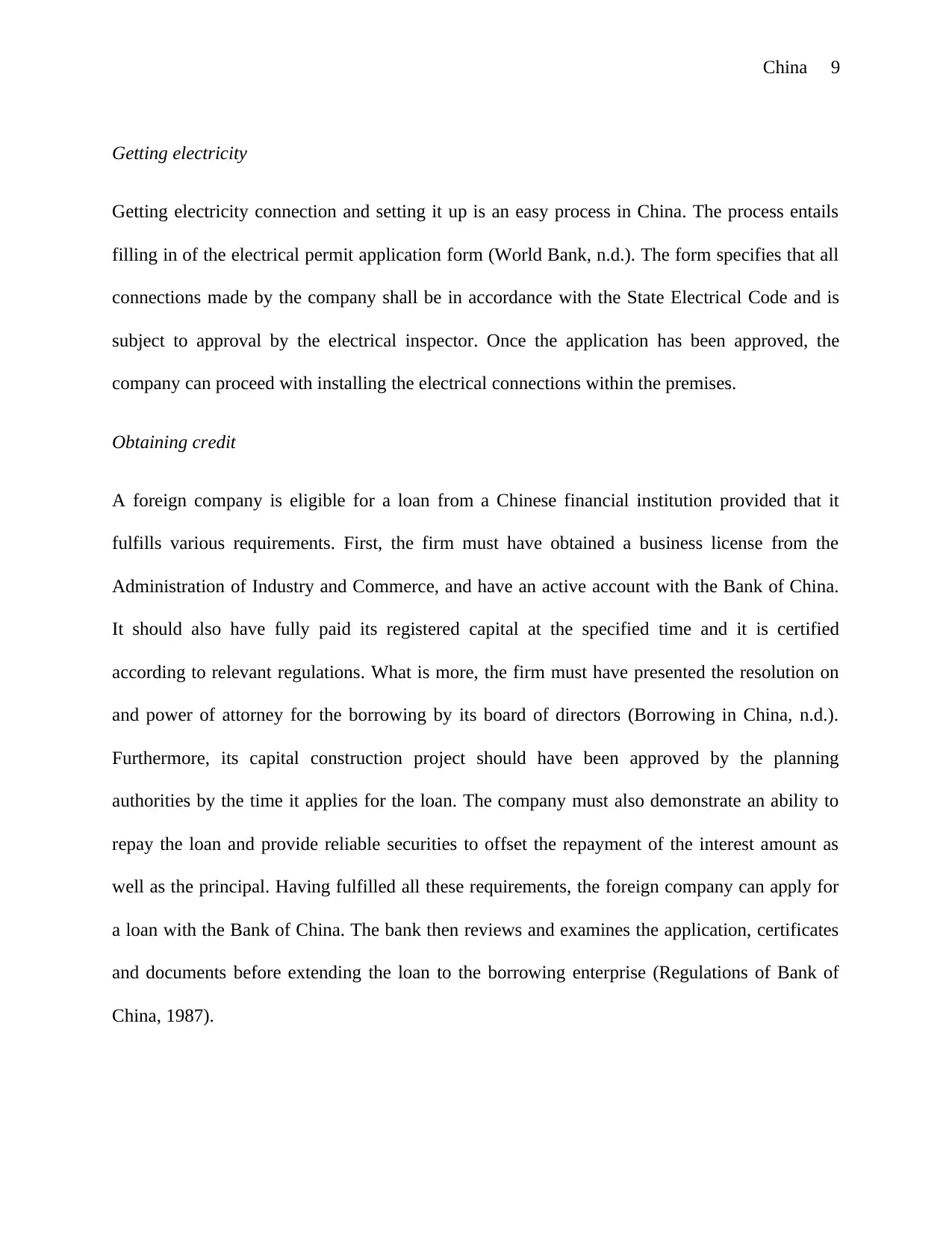
China 9
Getting electricity
Getting electricity connection and setting it up is an easy process in China. The process entails
filling in of the electrical permit application form (World Bank, n.d.). The form specifies that all
connections made by the company shall be in accordance with the State Electrical Code and is
subject to approval by the electrical inspector. Once the application has been approved, the
company can proceed with installing the electrical connections within the premises.
Obtaining credit
A foreign company is eligible for a loan from a Chinese financial institution provided that it
fulfills various requirements. First, the firm must have obtained a business license from the
Administration of Industry and Commerce, and have an active account with the Bank of China.
It should also have fully paid its registered capital at the specified time and it is certified
according to relevant regulations. What is more, the firm must have presented the resolution on
and power of attorney for the borrowing by its board of directors (Borrowing in China, n.d.).
Furthermore, its capital construction project should have been approved by the planning
authorities by the time it applies for the loan. The company must also demonstrate an ability to
repay the loan and provide reliable securities to offset the repayment of the interest amount as
well as the principal. Having fulfilled all these requirements, the foreign company can apply for
a loan with the Bank of China. The bank then reviews and examines the application, certificates
and documents before extending the loan to the borrowing enterprise (Regulations of Bank of
China, 1987).
Getting electricity
Getting electricity connection and setting it up is an easy process in China. The process entails
filling in of the electrical permit application form (World Bank, n.d.). The form specifies that all
connections made by the company shall be in accordance with the State Electrical Code and is
subject to approval by the electrical inspector. Once the application has been approved, the
company can proceed with installing the electrical connections within the premises.
Obtaining credit
A foreign company is eligible for a loan from a Chinese financial institution provided that it
fulfills various requirements. First, the firm must have obtained a business license from the
Administration of Industry and Commerce, and have an active account with the Bank of China.
It should also have fully paid its registered capital at the specified time and it is certified
according to relevant regulations. What is more, the firm must have presented the resolution on
and power of attorney for the borrowing by its board of directors (Borrowing in China, n.d.).
Furthermore, its capital construction project should have been approved by the planning
authorities by the time it applies for the loan. The company must also demonstrate an ability to
repay the loan and provide reliable securities to offset the repayment of the interest amount as
well as the principal. Having fulfilled all these requirements, the foreign company can apply for
a loan with the Bank of China. The bank then reviews and examines the application, certificates
and documents before extending the loan to the borrowing enterprise (Regulations of Bank of
China, 1987).
⊘ This is a preview!⊘
Do you want full access?
Subscribe today to unlock all pages.

Trusted by 1+ million students worldwide
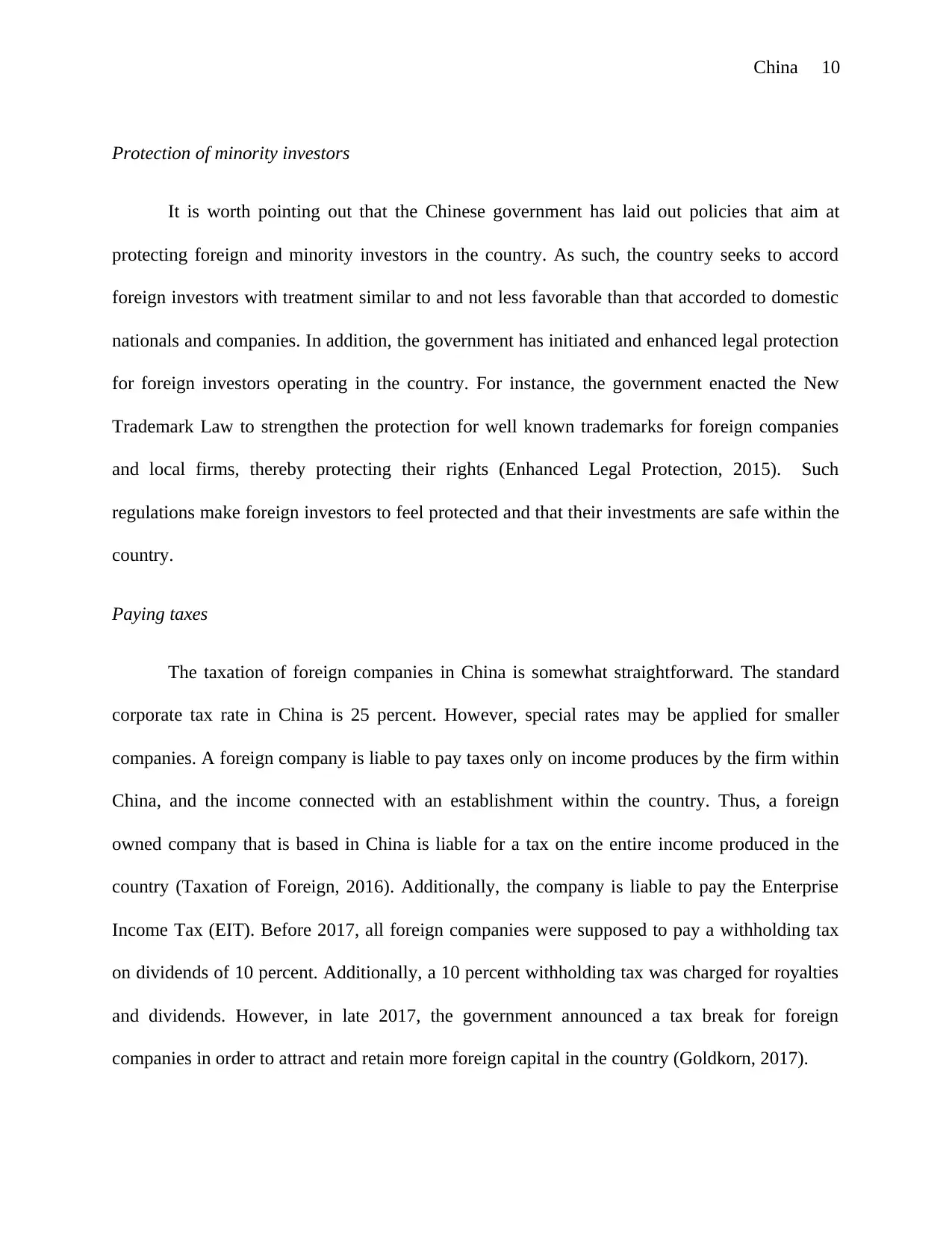
China 10
Protection of minority investors
It is worth pointing out that the Chinese government has laid out policies that aim at
protecting foreign and minority investors in the country. As such, the country seeks to accord
foreign investors with treatment similar to and not less favorable than that accorded to domestic
nationals and companies. In addition, the government has initiated and enhanced legal protection
for foreign investors operating in the country. For instance, the government enacted the New
Trademark Law to strengthen the protection for well known trademarks for foreign companies
and local firms, thereby protecting their rights (Enhanced Legal Protection, 2015). Such
regulations make foreign investors to feel protected and that their investments are safe within the
country.
Paying taxes
The taxation of foreign companies in China is somewhat straightforward. The standard
corporate tax rate in China is 25 percent. However, special rates may be applied for smaller
companies. A foreign company is liable to pay taxes only on income produces by the firm within
China, and the income connected with an establishment within the country. Thus, a foreign
owned company that is based in China is liable for a tax on the entire income produced in the
country (Taxation of Foreign, 2016). Additionally, the company is liable to pay the Enterprise
Income Tax (EIT). Before 2017, all foreign companies were supposed to pay a withholding tax
on dividends of 10 percent. Additionally, a 10 percent withholding tax was charged for royalties
and dividends. However, in late 2017, the government announced a tax break for foreign
companies in order to attract and retain more foreign capital in the country (Goldkorn, 2017).
Protection of minority investors
It is worth pointing out that the Chinese government has laid out policies that aim at
protecting foreign and minority investors in the country. As such, the country seeks to accord
foreign investors with treatment similar to and not less favorable than that accorded to domestic
nationals and companies. In addition, the government has initiated and enhanced legal protection
for foreign investors operating in the country. For instance, the government enacted the New
Trademark Law to strengthen the protection for well known trademarks for foreign companies
and local firms, thereby protecting their rights (Enhanced Legal Protection, 2015). Such
regulations make foreign investors to feel protected and that their investments are safe within the
country.
Paying taxes
The taxation of foreign companies in China is somewhat straightforward. The standard
corporate tax rate in China is 25 percent. However, special rates may be applied for smaller
companies. A foreign company is liable to pay taxes only on income produces by the firm within
China, and the income connected with an establishment within the country. Thus, a foreign
owned company that is based in China is liable for a tax on the entire income produced in the
country (Taxation of Foreign, 2016). Additionally, the company is liable to pay the Enterprise
Income Tax (EIT). Before 2017, all foreign companies were supposed to pay a withholding tax
on dividends of 10 percent. Additionally, a 10 percent withholding tax was charged for royalties
and dividends. However, in late 2017, the government announced a tax break for foreign
companies in order to attract and retain more foreign capital in the country (Goldkorn, 2017).
Paraphrase This Document
Need a fresh take? Get an instant paraphrase of this document with our AI Paraphraser
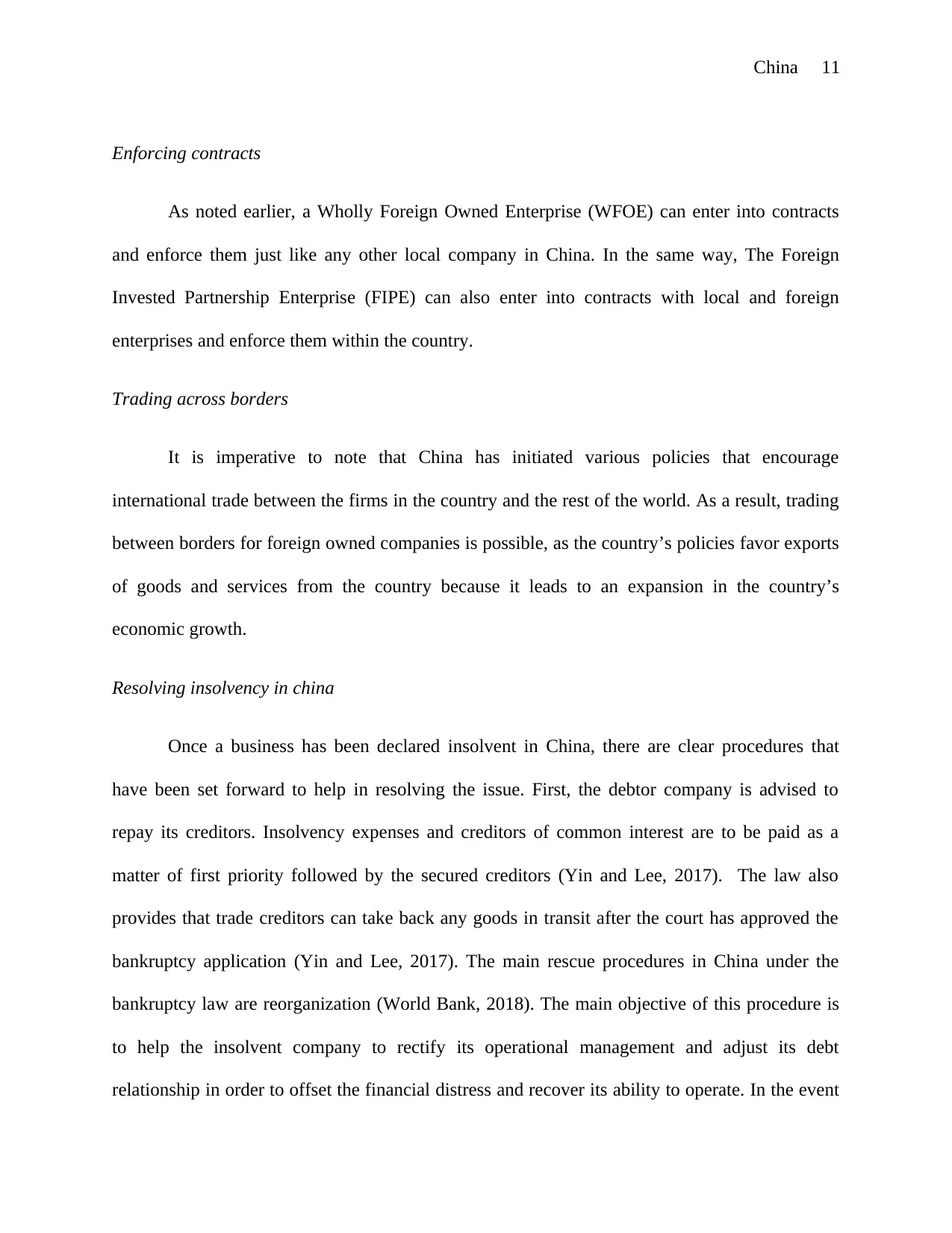
China 11
Enforcing contracts
As noted earlier, a Wholly Foreign Owned Enterprise (WFOE) can enter into contracts
and enforce them just like any other local company in China. In the same way, The Foreign
Invested Partnership Enterprise (FIPE) can also enter into contracts with local and foreign
enterprises and enforce them within the country.
Trading across borders
It is imperative to note that China has initiated various policies that encourage
international trade between the firms in the country and the rest of the world. As a result, trading
between borders for foreign owned companies is possible, as the country’s policies favor exports
of goods and services from the country because it leads to an expansion in the country’s
economic growth.
Resolving insolvency in china
Once a business has been declared insolvent in China, there are clear procedures that
have been set forward to help in resolving the issue. First, the debtor company is advised to
repay its creditors. Insolvency expenses and creditors of common interest are to be paid as a
matter of first priority followed by the secured creditors (Yin and Lee, 2017). The law also
provides that trade creditors can take back any goods in transit after the court has approved the
bankruptcy application (Yin and Lee, 2017). The main rescue procedures in China under the
bankruptcy law are reorganization (World Bank, 2018). The main objective of this procedure is
to help the insolvent company to rectify its operational management and adjust its debt
relationship in order to offset the financial distress and recover its ability to operate. In the event
Enforcing contracts
As noted earlier, a Wholly Foreign Owned Enterprise (WFOE) can enter into contracts
and enforce them just like any other local company in China. In the same way, The Foreign
Invested Partnership Enterprise (FIPE) can also enter into contracts with local and foreign
enterprises and enforce them within the country.
Trading across borders
It is imperative to note that China has initiated various policies that encourage
international trade between the firms in the country and the rest of the world. As a result, trading
between borders for foreign owned companies is possible, as the country’s policies favor exports
of goods and services from the country because it leads to an expansion in the country’s
economic growth.
Resolving insolvency in china
Once a business has been declared insolvent in China, there are clear procedures that
have been set forward to help in resolving the issue. First, the debtor company is advised to
repay its creditors. Insolvency expenses and creditors of common interest are to be paid as a
matter of first priority followed by the secured creditors (Yin and Lee, 2017). The law also
provides that trade creditors can take back any goods in transit after the court has approved the
bankruptcy application (Yin and Lee, 2017). The main rescue procedures in China under the
bankruptcy law are reorganization (World Bank, 2018). The main objective of this procedure is
to help the insolvent company to rectify its operational management and adjust its debt
relationship in order to offset the financial distress and recover its ability to operate. In the event
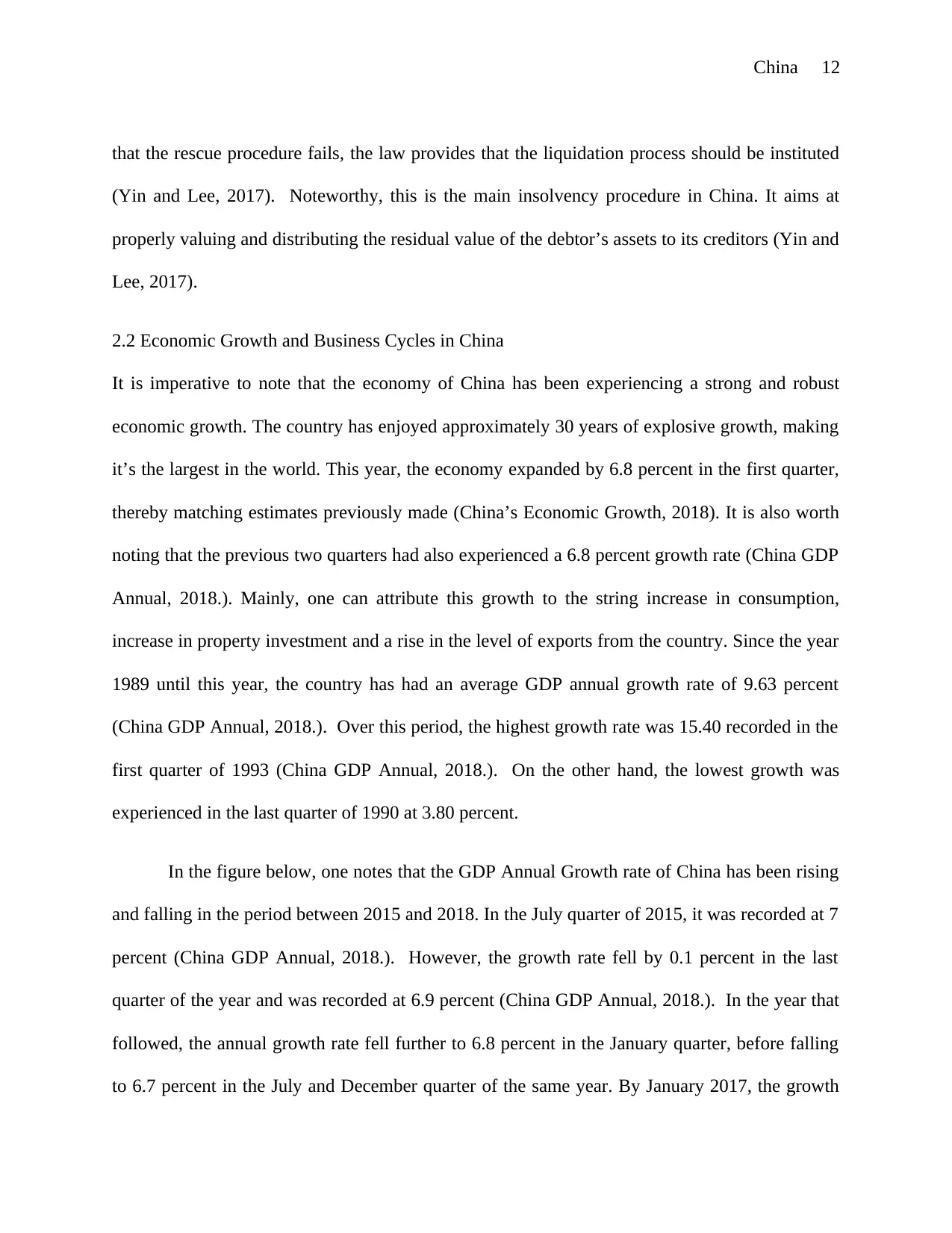
China 12
that the rescue procedure fails, the law provides that the liquidation process should be instituted
(Yin and Lee, 2017). Noteworthy, this is the main insolvency procedure in China. It aims at
properly valuing and distributing the residual value of the debtor’s assets to its creditors (Yin and
Lee, 2017).
2.2 Economic Growth and Business Cycles in China
It is imperative to note that the economy of China has been experiencing a strong and robust
economic growth. The country has enjoyed approximately 30 years of explosive growth, making
it’s the largest in the world. This year, the economy expanded by 6.8 percent in the first quarter,
thereby matching estimates previously made (China’s Economic Growth, 2018). It is also worth
noting that the previous two quarters had also experienced a 6.8 percent growth rate (China GDP
Annual, 2018.). Mainly, one can attribute this growth to the string increase in consumption,
increase in property investment and a rise in the level of exports from the country. Since the year
1989 until this year, the country has had an average GDP annual growth rate of 9.63 percent
(China GDP Annual, 2018.). Over this period, the highest growth rate was 15.40 recorded in the
first quarter of 1993 (China GDP Annual, 2018.). On the other hand, the lowest growth was
experienced in the last quarter of 1990 at 3.80 percent.
In the figure below, one notes that the GDP Annual Growth rate of China has been rising
and falling in the period between 2015 and 2018. In the July quarter of 2015, it was recorded at 7
percent (China GDP Annual, 2018.). However, the growth rate fell by 0.1 percent in the last
quarter of the year and was recorded at 6.9 percent (China GDP Annual, 2018.). In the year that
followed, the annual growth rate fell further to 6.8 percent in the January quarter, before falling
to 6.7 percent in the July and December quarter of the same year. By January 2017, the growth
that the rescue procedure fails, the law provides that the liquidation process should be instituted
(Yin and Lee, 2017). Noteworthy, this is the main insolvency procedure in China. It aims at
properly valuing and distributing the residual value of the debtor’s assets to its creditors (Yin and
Lee, 2017).
2.2 Economic Growth and Business Cycles in China
It is imperative to note that the economy of China has been experiencing a strong and robust
economic growth. The country has enjoyed approximately 30 years of explosive growth, making
it’s the largest in the world. This year, the economy expanded by 6.8 percent in the first quarter,
thereby matching estimates previously made (China’s Economic Growth, 2018). It is also worth
noting that the previous two quarters had also experienced a 6.8 percent growth rate (China GDP
Annual, 2018.). Mainly, one can attribute this growth to the string increase in consumption,
increase in property investment and a rise in the level of exports from the country. Since the year
1989 until this year, the country has had an average GDP annual growth rate of 9.63 percent
(China GDP Annual, 2018.). Over this period, the highest growth rate was 15.40 recorded in the
first quarter of 1993 (China GDP Annual, 2018.). On the other hand, the lowest growth was
experienced in the last quarter of 1990 at 3.80 percent.
In the figure below, one notes that the GDP Annual Growth rate of China has been rising
and falling in the period between 2015 and 2018. In the July quarter of 2015, it was recorded at 7
percent (China GDP Annual, 2018.). However, the growth rate fell by 0.1 percent in the last
quarter of the year and was recorded at 6.9 percent (China GDP Annual, 2018.). In the year that
followed, the annual growth rate fell further to 6.8 percent in the January quarter, before falling
to 6.7 percent in the July and December quarter of the same year. By January 2017, the growth
⊘ This is a preview!⊘
Do you want full access?
Subscribe today to unlock all pages.

Trusted by 1+ million students worldwide
1 out of 35
Related Documents
Your All-in-One AI-Powered Toolkit for Academic Success.
+13062052269
info@desklib.com
Available 24*7 on WhatsApp / Email
![[object Object]](/_next/static/media/star-bottom.7253800d.svg)
Unlock your academic potential
Copyright © 2020–2025 A2Z Services. All Rights Reserved. Developed and managed by ZUCOL.





